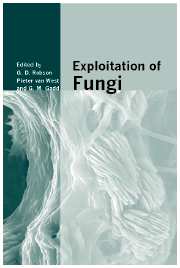Book contents
- Frontmatter
- Contents
- List of contributors
- Preface
- I Comparative and functional fungal genomics
- II Bioactive molecules
- III Protein folding and secretion
- IV Fungal bioremediation
- 10 Metal stress and the single yeast cell: Berkeley Award Lecture
- 11 Bioluminescence-based fungal biosensors
- 12 White-rot fungi and xenobiotics
- 13 Metal and mineral transformations: a mycoremediation perspective
- V Fungal biocontrol of pests
- Index
- References
13 - Metal and mineral transformations: a mycoremediation perspective
from IV - Fungal bioremediation
Published online by Cambridge University Press: 05 October 2013
- Frontmatter
- Contents
- List of contributors
- Preface
- I Comparative and functional fungal genomics
- II Bioactive molecules
- III Protein folding and secretion
- IV Fungal bioremediation
- 10 Metal stress and the single yeast cell: Berkeley Award Lecture
- 11 Bioluminescence-based fungal biosensors
- 12 White-rot fungi and xenobiotics
- 13 Metal and mineral transformations: a mycoremediation perspective
- V Fungal biocontrol of pests
- Index
- References
Summary
Introduction
In the periodic table, about 75% of the elements are classified as metals. While many metals are essential, e.g. K, Na, Ca, Mn, Mg, Fe, Cu, Zn, Co and Ni, many others have no apparent essential functions, e.g. Rb, Cs, Al, Cd, Ag, Au, Sr, U, Hg, Pb (Gadd, 1993). However, all can interact with fungi and most of them can exhibit toxicity above a certain threshold concentration, which will vary depending on the organism, metal species and environmental factors (Gadd & Griffiths, 1978; Gadd, 1993).
The redistribution of toxic metals in the biosphere as a result of human activity has become an important process in the biogeochemical cycling of these metals. The main source of metal pollution is industrialization including operational and former mining sites, foundries and smelters, untreated sewage sludge, and as diffuse sources, metal piping, traffic, combustion by-products from coal-burning power stations, and other atmospheric pollution. Arsenic, cadmium, chromium, copper, nickel, lead and mercury are the most common metal pollutants (Knox et al., 2000) with a selection of metal radionuclides also entering the environment from a number of sources (Gadd, 2005).
Unlike degradable organic contaminants, metals are not decomposed in the environment. They can, however, be buried (or otherwise contained), removed and recycled, or transformed into less toxic forms (Knox et al., 2000), these processes employing physical, chemical and biological methods singly or in combination.
- Type
- Chapter
- Information
- Exploitation of Fungi , pp. 236 - 254Publisher: Cambridge University PressPrint publication year: 2007
References
- 5
- Cited by



